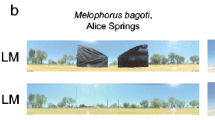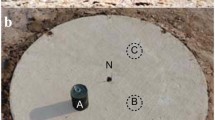Abstract
While foraging, desert ants of the genus Cataglyphis use a vector navigation (route integration) system for homing. Any vector navigation system requires that the animal is able to evaluate the angles steered and the distances travelled. Here we investigate whether the ants acquire the latter information by monitoring self-induced optic flow. To answer this question, the animals were trained and tested within perspex channels in which patterns were presented underneath a transparent walking platform. The patterns could be moved at different velocities (up to > 0.5 the ant's walking speed) in the same or in the opposite direction relative to the direction in which the animal walked. Experimental manipulations of the optic flow influenced the ant's homing distances (Figs. 2 and 4). Distance estimation depends on the speed of self-induced image motion rather than on the contrast frequency, indicating that the motion sensitive mechanism involved is different from mechanisms mediating the optomotor response. Experiments in which the ants walked on a featureless floor, or in which they wore eye covers (Fig. 6), show that they are able also to use additional (probably kinesthetic) cues for assessing their travel distance. Hence, even though optic flow cues are not the only ones used by the ants, the experiments show that ants are obviously able to exploit such cues for estimation of travel distance.
Similar content being viewed by others
References
David CT (1982) Compensation for height in the control of ground-speed by Drosophila in a new, ‘barber's pole’ wind tunnel. J Comp Physiol 147: 485–493
Esch HE, Burns JE (1995) Honey bees use optic flow to measure the distance of a food source. Naturwissenschaften 82: 38–40
Görner P (1958) Die optische und kinästhetische Orientierung der Trichterspinne Agelena labyrinthica. Z Vergl Physiol 41: 111–153
Görner P (1966) Über die Koppelung der optischen und kinästhetischen Orientierung bei den Trichterspinnen Agelena labyrinthica und Agelena gracilens. Z Vergl Physiol 53: 253–276
Götz KG (1964) Optomotorische Untersuchung des visuellen Systems einiger Augenmutanten der Fruchtfliege Drosophila Kybernetik 2: 77–92
Goller F, Esch HE (1990) Waggle dances of honey bees: is distance measured through energy expenditure on outward flight? Naturwissenschaften 77: 594–595
Heran H (1956) Ein Beitrag zur Frage nach der Wahrnehmungsgrundlage der Entfernungsweisung der Bienen. Z Vergl Physiol 38: 168–218
Heran H, Wanke L (1952) Beobachtungen über die Entfernungsmeldung der Sammelbienen. Z Vergl Physiol 34: 383–393
Kunze P (1961) Untersuchung des Bewegungssehens fixiert fliegender Bienen. Z Vergl Physiol 44: 656–684
Mittlelstaedt H, Mittelstaedt ML (1973) Mechanismen der Orientierung ohne richtende Außenreize. Fortschr Zool 21: 46–58
Müller M, Wehner R (1988) Path integration in desert ants, Cataglyphis fortis. Proc Natl Acad Sci USA 85: 5287–90
Neese V (1988) Die Entfernungsweisung der Sammelbiene: ein energetisches und zugleich sensorisches Problem. Biona Report 6: 1–15
Reichardt W (1969) Movement perception in insects. In: Reichardt W (ed) Processing of optical data by organisms and by machines. Acad Press, New York, pp 465–493
Sach L. (1984) Angewandte Statistik. Springer, Berlin
Schäfer M, Wehner R (1993) Loading does not affect measurement of walking distance in desert ants, Cataglyphisfortis. Verb Dtsch Zool Ges 86.1. G. Fischer, Stuttgart, p 270
Seyfarth EA, Barth FG (1972) Compound slit sense organs on the spider leg: mechanoreceptors involved in kinesthetic orientation. J Comp Physiol 78: 176–191
Seyfarth EA, Hergenröder R, Ebbes H, Barth FG (1982) Idiothetic orientation of a wandering spider: compensation of detours and estimates of goal distance. Behav Ecol Sociobiol 11: 139–148
Sokal RR, Rohlf FJ (1981) Biometry. Freeman, New York
Srinivasan M (1992) How bees exploit optic flow: behavioural experiments and neural models. Phil Trans R Soc Lond B 337: 253–259
Srinivasan M, Lehrer M, Kirchner WH, Zhang SW (1991) Range perception through apparent image speed in freely flying honey-bees. Visual Neuroscience 6: 519–535
Srinivasan M, Zhang SW, Chandrashekaran K (1993) Evidence for two distinct movement-detecting mechanisms in insect vision. Naturwissenschaften 80: 38–41
Wehner R (1981) Spatial vision in arthropods. In: Autrum H (ed) Handbook of sensory physiology, vol VII/6C. Springer, Berlin Heidelberg, New York, pp 287–616
Wehner R (1982) Himmelsnavigation bei Insekten. Neurophysiologie und Verhalten. Neujahrsbl Naturforsch Ges Zürich 184: 1–132
Wehner R (1992) Homing in arthropods. In: Papi F (ed) Animal homing. Chapman and Hall, London, pp 45–144
Wehner R (1994) The polarization vision project: championing organismic biology. In: Schildberger K, Elsner N (eds) Neural basis of behavioural adaptations. Fortschr Zoologie, vol. 39, G. Fischer, Stuttgart, pp 103–143
Wehner R, Müller M (1985) Does interocular transfer occur in visual navigation by ants? Nature 315: 228–229
Wehner R, Srinivasan M (1981) Searching behaviour of desert ants, Genus Cataglyphis (Formicidae, Hymenoptera). J Comp Physiol 142: 315–338
Wehner R, Wehner S (1990) Insect navigation: use of maps or Ariadne's thread? Ethol Ecol Evol 2: 27–48
Author information
Authors and Affiliations
Rights and permissions
About this article
Cite this article
Ronacher, B., Wehner, R. Desert ants Cataglyphis fortis use self-induced optic flow to measure distances travelled. J Comp Physiol A 177, 21–27 (1995). https://doi.org/10.1007/BF00243395
Accepted:
Issue Date:
DOI: https://doi.org/10.1007/BF00243395




